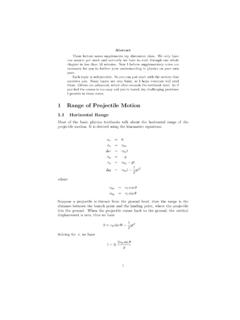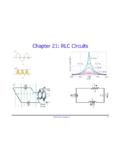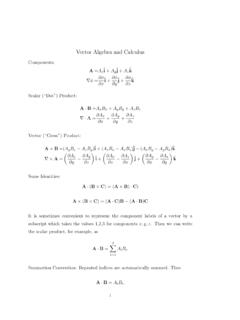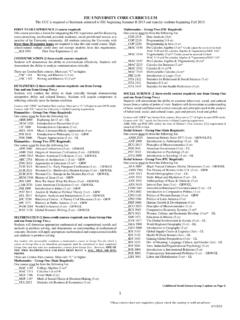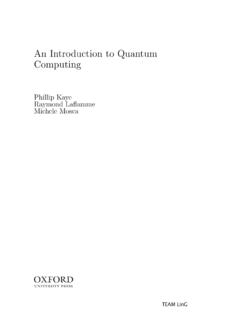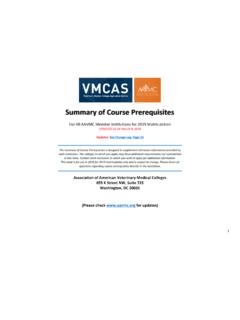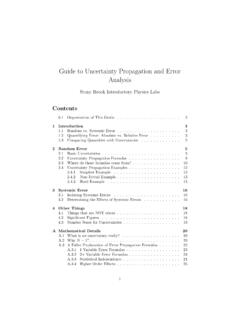Transcription of Introduction to Measurement in the Physics Laboratory
1 University of Cape Town Department of Physics Introduction to Measurement in the Physics Laboratory A probabilistic approach Version 2009 Introduction to Measurement in the Physics Laboratory A probabilistic approach Andy Buffler and Saalih Allie Department of Physics , University of Cape Town, South Africa Fred Lubben and Bob Campbell Science Education Group, Department of Educational Studies, University of York, UK To the student As a science, engineering or medical graduate, it will be assumed by your future employer that you have certain skills. These will include problem solving skills, the ability to engage with apparatus that you may not have seen before, the ability to plan and execute an experiment or some type of investigation, the ability to collect, analyse and interpret data and very importantly the ability to communicate and present your findings either orally or in the form of a written report.
2 The contents of this book may be viewed as a complementary course to the practicals that you will undertake in the Laboratory as well as a reference manual. As certain skills become necessary in the Laboratory , you will have the opportunity to develop these skills using the examples and doing the exercises in this manual. It is thus intended that, (a) during your Laboratory course, you will work through the exercises and examples in this manual at the appropriate stage, and (b) this book be used as a reference handbook when you do practical work in the Laboratory and then write up your experience in the form of a report. The tasks in this book have been designed to assist you in developing these skills.
3 It is intended this book to be used in a cooperative learning environment. We believe that working in groups of 3 is best for these activities. Compare your responses to those of your work partners. Help each other to figure out what is going on. Resolve any difficulties that you might have and call a tutor or lecturer if you need to. Do not proceed to the next activity until you are completely clear about what you have just completed. To the instructor Traditionally Physics Laboratory courses at introductory level have aimed to demonstrate various principles of Physics introduced in lectures. Experiments tend to be quantitative in nature and thus experimental and data analysis techniques are interwoven as distinct strands of the Laboratory course.
4 It is often assumed that, in this way, students will end up with an understanding of the nature of Measurement and experimentation. Recent research studies have, however, questioned this assumption. They have pointed to the fact that students who have completed Physics Laboratory courses are often able to demonstrate mastery of the mechanistic techniques ( calculating means and standard deviations, fitting straight lines, etc.), but lack an appreciation of the nature of scientific evidence, in particular the central role of uncertainty in experimental Measurement . Although one of the most important aspects of putting together a teaching sequence is bringing together the philosophy, logic and modes of thinking that underlie a particular knowledge area, introductory Measurement is usually taught as a combination of apparently rigorous mathematical computations and vague rules of thumb.
5 We believe that this is a consequence of the logical inconsistencies in traditional data analysis, which is based on the frequency interpretation of probability. This approach, often called frequentist , is the one used or implied in most introductory Laboratory courses. In the frequentist approach, errors are usually introduced as a product of the limited capability of measuring instruments, or in the case of repeated measurements, as a consequence of the inherent randomness of the Measurement process and the limited predictive power of statistical methods. These two different sources of errors cannot be easily reconciled, thus creating a gap between the treatment of a single reading and of ensembles of dispersed data.
6 For example, the theory applicable to calculating a mean and a standard deviation is premised on the assumption of large datasets (20 or 30). Yet, when students perform an experiment in the Laboratory they often take 5 or fewer readings. Furthermore, there is no logical way to model statistically a single Measurement within this approach. Traditional instruction usually emphasizes random error for which there is a rigorous mathematical model, while systematic errors are reduced to the technical level of unknown constants that have to be determined by examining the experimental setup. The concept of scale reading error , usually taught at the beginning of the course, cannot be related to either random or systematic errors that are taught during the treatment of repeated measurements.
7 Moreover, the term error misleads students by suggesting the existence of true and false experimental results, possibly endorsing the na ve view that an experiment has one predetermined correct result known by the instructor, while students measurements are often in error. Readers will be all too familiar with the phrase due to human error often used by students in order to explain unexpected results. We believe that the logical inconsistencies in the traditional approach to data treatment, together with the form of instruction that ignores students prior views about Measurement , further cultivate students misconceptions about Measurement in the scientific context.
8 The need for a consistent international language for evaluating and communicating Measurement results prompted (in 1993) the ISO (International Organization for Standardization) to publish recommendations for reporting measurements and uncertainties based on the probabilistic interpretation of Measurement . Many standards bodies including BIPM Bureau International des Poids et Mesures IEC International Electrotechnical Commission IFCC International Federation of Clinical Chemistry IUPAC International Union of Pure and Applied Chemistry IUPAP International Union of Pure and Applied Physics OIML International Organization of Legal Metrology NIST National Institute of Standards and Technology (US) have adopted these recommendations for reporting scientific measurements.
9 A number of documents currently serve as international standards. The most widely known are the so-called VIM (International Vocabulary of Basic and General Terms in Metrology) and the GUM (Guide to the Expression of Uncertainty in Measurement ). We believe this course based on the probabilistic approach advocated by ISO will help in setting up a systematic teaching framework at an introductory level and beyond, and promote a better understanding of the nature of Measurement and uncertainty. In addition, the coherence of the approach will foreground the central role of experiment in Physics and the interplay between scientific inferences based on data and theory.
10 AB, MSA, FEL, RMC November 2002 Please inform the authors before using these materials in any teaching situation. We would also be interested in any feedback you might have. Acknowledgements The authors are grateful to the following people for contributing to the development of this book: Prof Sandy Perez (UCT), Dr. Roger Fearick (UCT), Prof Craig Comrie (UCT), Dimitris Evangelinos (U. Thessaloniki), Prof. Dimitris Psillos (U. Thessaloniki), Prof. Robin Millar (UoY), Prof. Joe Redish (U. Maryland), Prof. Derek Boyd (U. Maryland), Prof Cedric Linder (U. Uppsala), Trevor Volkwyn (UCT), and the many part time teaching assistants without whom Laboratory work would be a disaster.

